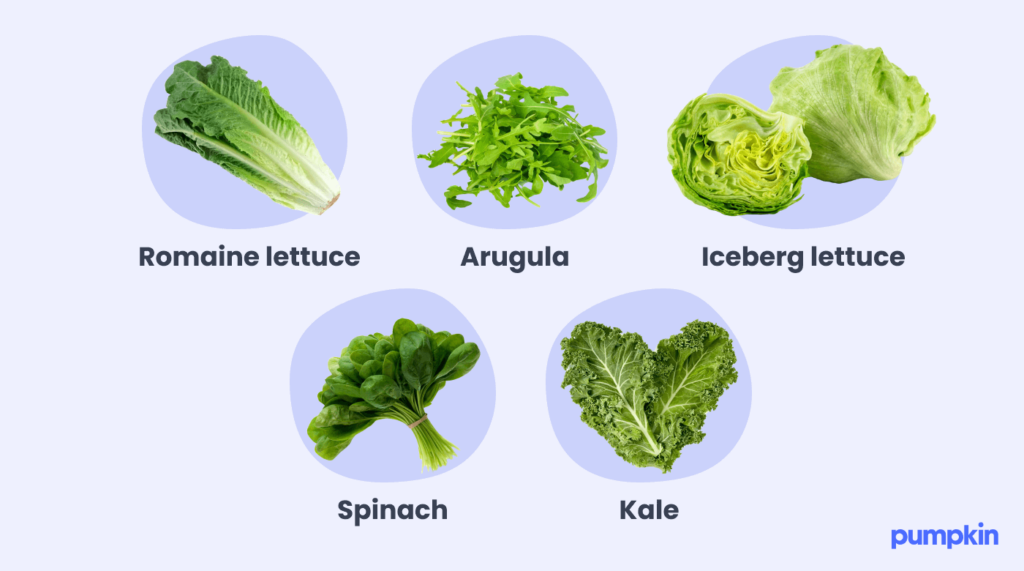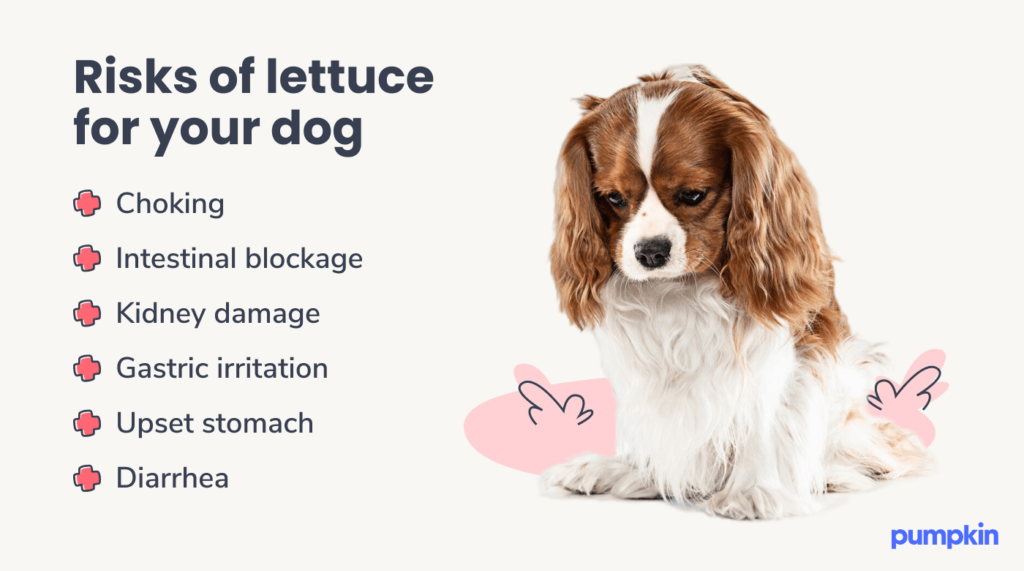Key Points:
- Yes, dogs can eat lettuce, but it should be chopped finely and served in moderation.
- Lettuce provides dogs with vitamin A, vitamin C, iron, vitamin K, fiber, and water.
- Avoid lettuce with salad dressings or seasonings, which can be harmful to dogs.
Human nutritional guidelines encourage us to pile on leafy greens for a balanced diet, but can dogs eat lettuce too?
The answer is yes, dogs can eat lettuce, but don’t simply replace their kibble with salad if your vet tells you they’re a tad overweight. When served correctly, this low-calorie veggie snack offers numerous health benefits for pups. And if you’ve seen your dog chomping down on grass and other plants, they may even appreciate a little lettuce in their diet.
But before you let your pooch go full bunny-mode, let’s look at the benefits, risks, and tips for giving lettuce to dogs.
Does lettuce have nutritional benefits for dogs?
Yes, this leafy veggie provides a healthy dose of important micronutrients including minerals and vitamins C, A, and K.

Vitamin C and A are antioxidants that boost your dog’s immune system and combat free radicals. These vitamins can also reduce inflammation, protect the heart, and reduce the effects of aging.
Vitamin A also supports healthy vision as well as growth and development, especially in puppies. Vitamin K aids in blood clotting and coagulation, which prevents excessive bleeding when injured. Calcium builds strong bones and teeth and supports ligament and muscle development. It is also crucial for a strong heart and a healthy nervous system.
Folate, also known as folic acid, helps normal metabolic functions such as DNA and red blood cell synthesis. Potassium, on the other hand, aids heart, nerve, and muscle functions.
What are the other benefits of lettuce for dogs?
Lettuce varieties have different levels of nutrients. However, they have some common benefits that make them an ideal treat for your pup. These benefits include:
High fiber content
Lettuce is a healthy treat for dogs due to its high amounts of dietary fiber. Fiber plays a vital role in aiding digestion and clearing diarrhea and constipation symptoms.
Similarly, fiber can improve diabetes mellitus in dogs by slowing digestion. This results in fewer blood-sugar level fluctuations. Many fruits and veggies aren’t good snack options for diabetic dogs, but lettuce is an exception.
Weight management
Because it’s over 90% water, lettuce helps with weight management in pets. Whether you are looking to help your pup lose some weight or stay healthy, lettuce is a guilt-free snack option — as long as they like the taste.
The fiber in lettuce also helps your pooch stay full for longer while eating fewer calories, which helps them lose weight.
The best types of lettuce for dogs
Your dog can safely eat several types of leafy greens, including arugula, romaine lettuce, spinach, and butterhead lettuce.

The following types of lettuce contain plenty of vitamins and minerals for your dog, and they are all pup-friendly.
- Iceberg lettuce: Iceberg lettuce is a good source of several vitamins, including vitamins C and A. It’s not as nutrient-rich, however, as darker lettuces and leafy greens.
- Butterhead lettuce: Butterhead lettuce offers vitamins C, A, and K. It’s also rich in iron.
- Red leaf lettuce: Leaf lettuce varies in color and shape. The red leaf variety is high in vitamin A and contains more iron and vitamin K than the green leaf variety.
- Romaine lettuce: Romaine lettuce is the most nutrient-dense in the lettuce family. It’s packed with vitamin A. It’s also a good source of iron and vitamin C.
Risks of lettuce
Nutritionally balanced dog food should comprise 90% of your dog’s daily diet. Treats should only make up to 10% of their daily caloric intake. That includes healthy treats like lettuce.
Here are some small risks you should know when feeding lettuce to hungry dogs.
Allergy or intolerance
Lettuce is low on the allergen scale, but some dogs can still have adverse reactions. This is why you should check with your veterinarian before offering any new foods or snacks.

Choking hazard
Lettuce leaves are quite fibrous and hard to digest. Cutting or tearing them into bite-sized pieces can help with digestion and prevent choking or blockage in the digestive tract.
Harmful nutritional compounds
Kale and spinach both contain oxalic acid and isothiocyanates. Oxalic acid inhibits the body’s ability to absorb calcium and magnesium. It may also damage the kidneys. When consumed in large amounts, it can lead to toxicity. Isothiocyanates, on the other hand, are organic compounds that can cause gastric irritation — and unpleasant doggy farts.
Bacterial contamination
E. Coli, Listeria, and Salmonella are found in soil and may be present on unwashed lettuce. They can cause severe stomach problems when ingested. However, carefully washing the lettuce leaves before serving them helps get rid of these nasty bacteria. Often that requires soaking them in a bowl rather than simply rinsing them in the sink.
Toxic additional ingredients
The greatest risk with salads is the additional ingredients. It’s tempting when your pup pleads for bites of your human food, and salad seems healthy, right? Individually, salad ingredients probably are (except for foods like onions, and walnuts, which are toxic). However, when put together, they can have potential health risks.
Similarly, salad dressing may contain excess oil, fat, sugar, and xylitol, an artificial sweetener that is highly toxic to dogs. It may also have onion powder or spices your pup’s system won’t agree with. Instead of sharing your salad, share plain lettuce or tomatoes that have been washed and prepared separately from your salad.
How to prepare lettuce for snack time
When offering treats to your pooch, our rule of thumb is always the same: moderation, moderation, moderation. And with produce like lettuce, be sure to wash the leaves thoroughly.
Steaming lettuce like spinach with a few green beans will help your dog digest and chew the tough leaves, especially puppies.
You can also mix lettuce into smoothies with different fruits, vegetables, and plain Greek yogurt. If you choose to add kale or spinach to your DIY treats, keep the amounts small to avoid any toxicity. Here are a few tasty-looking recipes:
Feeding dogs lettuce: the bottom line
Lettuce is a healthy snack, but the ingredients you eat with your lettuce might be a hard no. Avoid salad dressings and other fixings, which can mess with your pup’s tummy. Also, always talk to your veterinarian before introducing any new foods and treats. It’s your job as a pet parent to look after your pup when their appetite leads them into trouble. Learn more about how Pumpkin Pet Insurance plans can help you with eligible vet costs in the future.
Updated on Feb. 10, 2025: A previous version of this article incorrectly described the nutrient chlorophyll as one of the benefits of lettuce. After consulting a veterinarian, we have removed this section. We also updated our list of references.
FAQs
- https://www.medicalnewstoday.com/articles/301506#benefits
- https://www.ncbi.nlm.nih.gov/pmc/articles/PMC8172435/
- https://www.ncbi.nlm.nih.gov/pmc/articles/PMC3513714/
- https://vetmed.tamu.edu/gilab/research/folate-information/
- https://www.akc.org/expert-advice/nutrition/benefits-high-fiber-dog-foods/
- https://www.planetfitness.com/community/articles/eat-more-water-try-these-8-hydrating-foods
- https://doi.org/10.1111/jpn.13626
- https://fdc.nal.usda.gov/fdc-app.html#/food-details/169248/nutrients
- https://fdc.nal.usda.gov/fdc-app.html#/food-details/168429/nutrients
- https://fdc.nal.usda.gov/fdc-app.html#/food-details/168431/nutrients
- https://fdc.nal.usda.gov/fdc-app.html#/food-details/169247/nutrients
- https://pubmed.ncbi.nlm.nih.gov/22548678/
- https://poisonousplants.ansci.cornell.edu/toxicagents/glucosin.html
- https://dogchild.co/blogs/recipes/caesar-salad-lick-mat-recipe-for-dogs
- http://www.dogtreatkitchen.com/homemade-dog-cookies.htmlhttp://www.dogtreatkitchen.com/fat-dog.html




